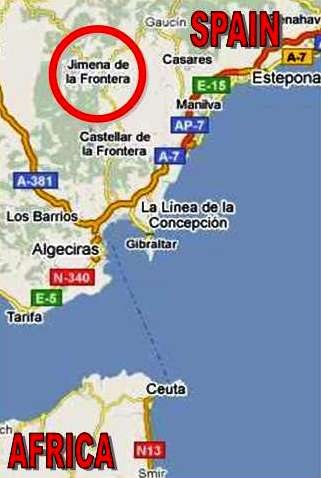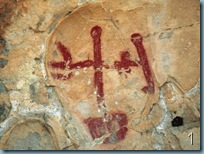 Laja Alta
Laja Alta is a natural shelter set in the rocks at the end of the Garganta de Gamero, on a vertical escarpment, with a cave worked into the siliceous rock of the area. The style here is of the so-called schematic art that has been dated to the first phase of the Bronze Age.
The paintings here represent a variety of themes that go from anthropomorphic stick figures (photo 1), often cruciform or in the shape of the Greek ‘Pi’ s
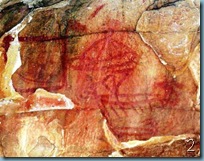
ymbol, passing through symbolic idols, circular or geometric motifs, to representations of ships (photo 2). The latter are of exceptional historical value, as they are the only maritime scenes of the Iberian Bronze Age. It has been proposed that the Straits of Gibraltar were wider than they are today and that this area was thus closer to the sea, which would mean that these settlers knew about sailing, or at least were able to watch sea-going vessels from here. According to the chronology, we can deduce that these cave paintings coincided with the arrival of the Phoenicians to these parts. The artist of Laja Alta was therefore able to tell his fellows about the Bay of Algeciras towards the end of the Bronze Age (about 1000 B.C.), criss-crossed as it might have been by colonising sailing ships. These are some of the last remaining representations of schematic painting and are similar to others found in the Sahara.
You will need a guide to take you there, although occasional organized visits do occur. These may well be announced on JimenaPulse or CampoPulse, our partner sites, to which you can subscribe easily.
____________________________________________________________
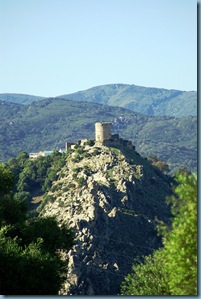 The castle
The castle, declared a National Monument in 1931, was part of a defensive system that went from Olvera in the North, to Tarifa in the South. The system included tower castles at Torre Alháquime, Setenil, Xahara, Matrera, Tavizna (Aznalmara), Cardela, Jimena, Castellar and Algeciras. This line of defence was more complete than that on the coast. Although it is thought the present castle was built in the XIII Century, it would appear that it has Roman origins, possibly even Phoenician.
The fortifications surrounded a central area with square towers at regular intervals. Access was along a cobbled pathway of some 85 metres in length which may have been of Roman origin.
The fortifications played a vital part during the Nazarite period, the remains of which - the round, central tower and the entrance tower, the walls, the cisterns or reservoirs - are still there to see. The castle watches, serenely and majestically, over a village that seems to be pasted onto the hillside it presides.
________________________________________________________________
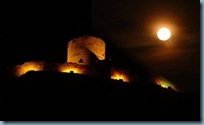 The Tower of Homage
The Tower of Homage, with a height of 13 metres, has circular exterior that hides an interior, older and smaller tower of polygonal shape at its base.
The two-story tower contains a much-restored vaulted ceiling that could belong to the Islamic period, which would be exceptional as most Islamic towers in the West tend to be square shaped, rectangular or polygonal, but not circular.
_______________________________________________________________
![clip_image002[5]](http://holidaysinjimena.files.wordpress.com/2008/12/clip-image0025-thumb.jpg) The Lookout Tower
The Lookout Tower is
located on the less steep part of the hill, it is 6.30 m wide, 4.53 m long and 13.19 m tall. It is an advance tower, with a vaulted brick ceiling. Access was through the extant passageway above the entry arch. It is known locally as
La Torre del Reloj, or Clock Tower, though there was never a clock involved, except that perhaps it contained a sun dial, possibly during the Islamic period (another fanciful possibility is a modern mistranslaton of watch tower, a wristwatch being a
reloj in Spanish, which also means clock).
________________________________________________________
 The Moorish Queen’s Bath,
The Moorish Queen’s Bath, or
Baño de la Reina Mora, is the name given to a large basin behind the Castle. It is thought that this might be the remains of an ancient Mozarab church carved out of the rock, in the style of the church at Bobastro. To the left of the basin is a vertical wall containing four niches, three of which are triangular, plus a rectangular one, above which are three small niches. It is possible that the rectangular one was an altar and the triangular ones used to place venerated objects. What is known as the ‘bath’ is almost certainly a basin used for the rite of baptism.
________________________________________________________________________
![clip_image002[7]](http://holidaysinjimena.files.wordpress.com/2008/12/clip-image0027-thumb.jpg) The Royal Artillery Factory
The Royal Artillery Factory, built at the orders of King Carlos III in 1777, made cannonballs and bombs, many of which were used during the Great Siege of Gibraltar, although most of its production was destined for the Indies (America).
The factory ceased production towards the end of the winter of 1788 / 89. The only principal remains of it are the water channel, or ‘Cao’, on the left bank of the Hozgarganta River (photo). It was used to transport water to a large iron foundry at Pasada de Alcalá. The upper part of the channel is made of ashlar stones, and the rest of river stone and lime and sand mortar. The water brought down by this channel was later used to move the millstones at the flour mills built later in the vicinity.
______________________________________________________________
![clip_image002[9]](http://holidaysinjimena.files.wordpress.com/2008/12/clip-image0029-thumb.jpg)
The mountains of the Campo de Gibraltar have always had a large quantity of
flour mills, the principal reason being the climate. In Jimena, these mills were built mainly on the riverbank, to make use of the water channel and the waterfalls nearby. They fell into disuse as the result of competition from modern, motorised and electrified industry. In Jimena there are the remains of the San Francisco mills, the ‘Molino de Rodete’, ‘Molino de Gaitán’ and ‘Molino Felipe’.
____________________________________________________________________
 Architectural heritage.
Architectural heritage. With the conquest of the peninsular remains of the Nazarite Kingdom of Granada, most of the Moorish Andalusians that lived on the frontiers between Christians and Moors ran to safety. This meant that the newly-taken territories had to be re-populated with people from the Kingdom of Castille.
Jimena received people from the Northern mountains of Huelva, who inhabited the upper part of the village, within the castle walls. This meant, in turn, that the growing village had to be expanded along the slopes of the hill, which was less safe in terms of the ground upon which the new inhabitants built their homes. It is also the reason that Jimena’s houses were built upwards, rather than spreading outwards.
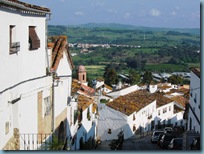
Crowned by its Castle, the streets of Jimena follow the natural curvature of the slopes until they reach the bottom of the hill, when they become wider. This configuration of the village has created the attractive urban panorama of today. Representative of this past are the Arabic roof tiles that give the village its colour, the whitewashed walls and the typically Andalusian ironwork of the windows.
_____________________________________________________________________
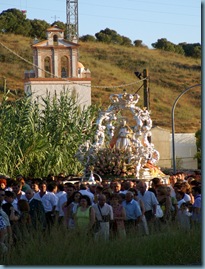 Sanctuary of Our Lady of the Angels
Sanctuary of Our Lady of the Angels (
Santuario de Nuestra Señora de los Ángeles). Also known as ‘the Convent’, or
Convento, and located within the nearby village of Los Ángeles, the Sanctuary was built in 1450 as a Franciscan monastery. It was expanded in the XVII Century, to include an order of Minim monks, which was disbanded in 1820. The Sanctuary has a splendid cloister and a svelte bell tower. The Virgin’s chamber is a classic sample of the Baroque period. Presently under renovation, several fresco inscriptions and paintings have been uncovered. According to historical documents , the image of Our Lady of the Angels (in photo during procession, with the Convent behind), Patron Saint of the village, dates from the year 190 AD and was brought from Antioch to Spain.
_____________________________________________________________________
 Church of Our Lady St. Mary the Crowned
Church of Our Lady St. Mary the Crowned (
Iglesia de Santa María la Coronada). Set within the Baroque period, construction began in the XVII Century. The first reference to it comes from a book published in 1690. The only extant part, the bell tower, is of the local architectural style, that is, with a smooth lower part, while the upper is made of visible brick. The tower is located in the main square, the Plaza de la Constitución, better known locally as
El Paseo. Within, is a winding staircase made of solid stone. A long-time resident of Jimena, British archaeologist Hamo Sassoon, suggested that the original tower may have been a minaret that was later built over to form part of the church, a common trait all over Spain after the Islamic period.
_____________________________________________________________________

The
Church of Our Lady of Victory (
Iglesia de la Victoria) takes its name from the Patron Saint of Málaga. The Catholic Kings, Ferdinand and Isabella, received the image of St. Mary from the Emperor Maximillian of Austria, and gave it the name ‘Of Victory’ on the day they took the city of Málaga from the Moors. It was later gifted to the Minim Congregation with its chapel. Only two naves remain, but the façade, bell tower and door are worth noting, as is the cloister. Initial construction dates from 1583. One of the most attractive stage settings for the International Music Festival of Jimena, underwent some changes to convert it into a charming amphitheatre to better accommodate the audience without changing its character.
______________________________________________________________________
![clip_image002[13]](http://holidaysinjimena.files.wordpress.com/2008/12/clip-image00213-thumb.jpg)
The
Church of ‘La Misericordia’ is no longer a church but could well be the first church built following the Christian conquest of Jimena, which would place its date within the second half of the XV Century. Located just below the Castle, it would not be surprising if it was built on the site of a Mosque. It has been well restored and within its stone walls today are the
Tourism Office and the
Los Alcornocales Nature Park Information Point. It is also used frequently for recitals and concerts by visiting musicians.
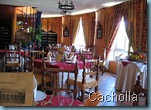
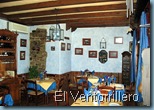
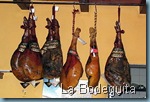
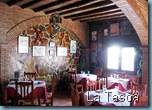


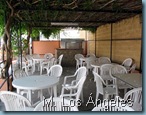
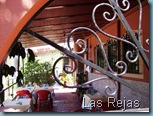
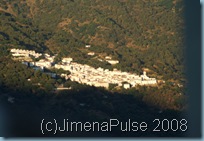
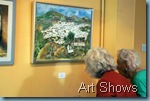

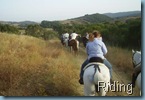
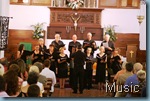


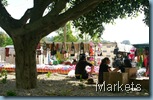

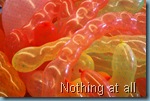




![clip_image002[5]](http://holidaysinjimena.files.wordpress.com/2008/12/clip-image0025-thumb.jpg)

![clip_image002[7]](http://holidaysinjimena.files.wordpress.com/2008/12/clip-image0027-thumb.jpg)
![clip_image002[9]](http://holidaysinjimena.files.wordpress.com/2008/12/clip-image0029-thumb.jpg)





![clip_image002[13]](http://holidaysinjimena.files.wordpress.com/2008/12/clip-image00213-thumb.jpg)
